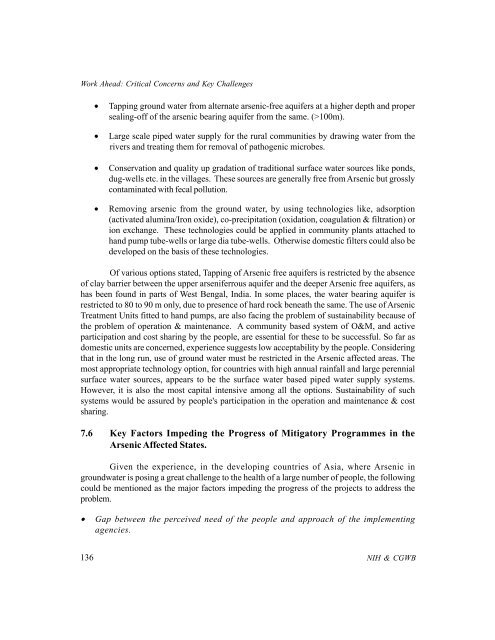Mitigation and Remedy of Groundwater Arsenic Menace in India
Mitigation and Remedy of Groundwater Arsenic Menace in India
Mitigation and Remedy of Groundwater Arsenic Menace in India
You also want an ePaper? Increase the reach of your titles
YUMPU automatically turns print PDFs into web optimized ePapers that Google loves.
Work Ahead: Critical Concerns <strong>and</strong> Key Challenges• Tapp<strong>in</strong>g ground water from alternate arsenic-free aquifers at a higher depth <strong>and</strong> properseal<strong>in</strong>g-<strong>of</strong>f <strong>of</strong> the arsenic bear<strong>in</strong>g aquifer from the same. (>100m).• Large scale piped water supply for the rural communities by draw<strong>in</strong>g water from therivers <strong>and</strong> treat<strong>in</strong>g them for removal <strong>of</strong> pathogenic microbes.• Conservation <strong>and</strong> quality up gradation <strong>of</strong> traditional surface water sources like ponds,dug-wells etc. <strong>in</strong> the villages. These sources are generally free from <strong>Arsenic</strong> but grosslycontam<strong>in</strong>ated with fecal pollution.• Remov<strong>in</strong>g arsenic from the ground water, by us<strong>in</strong>g technologies like, adsorption(activated alum<strong>in</strong>a/Iron oxide), co-precipitation (oxidation, coagulation & filtration) orion exchange. These technologies could be applied <strong>in</strong> community plants attached toh<strong>and</strong> pump tube-wells or large dia tube-wells. Otherwise domestic filters could also bedeveloped on the basis <strong>of</strong> these technologies.Of various options stated, Tapp<strong>in</strong>g <strong>of</strong> <strong>Arsenic</strong> free aquifers is restricted by the absence<strong>of</strong> clay barrier between the upper arseniferrous aquifer <strong>and</strong> the deeper <strong>Arsenic</strong> free aquifers, ashas been found <strong>in</strong> parts <strong>of</strong> West Bengal, <strong>India</strong>. In some places, the water bear<strong>in</strong>g aquifer isrestricted to 80 to 90 m only, due to presence <strong>of</strong> hard rock beneath the same. The use <strong>of</strong> <strong>Arsenic</strong>Treatment Units fitted to h<strong>and</strong> pumps, are also fac<strong>in</strong>g the problem <strong>of</strong> susta<strong>in</strong>ability because <strong>of</strong>the problem <strong>of</strong> operation & ma<strong>in</strong>tenance. A community based system <strong>of</strong> O&M, <strong>and</strong> activeparticipation <strong>and</strong> cost shar<strong>in</strong>g by the people, are essential for these to be successful. So far asdomestic units are concerned, experience suggests low acceptability by the people. Consider<strong>in</strong>gthat <strong>in</strong> the long run, use <strong>of</strong> ground water must be restricted <strong>in</strong> the <strong>Arsenic</strong> affected areas. Themost appropriate technology option, for countries with high annual ra<strong>in</strong>fall <strong>and</strong> large perennialsurface water sources, appears to be the surface water based piped water supply systems.However, it is also the most capital <strong>in</strong>tensive among all the options. Susta<strong>in</strong>ability <strong>of</strong> suchsystems would be assured by people's participation <strong>in</strong> the operation <strong>and</strong> ma<strong>in</strong>tenance & costshar<strong>in</strong>g.7.6 Key Factors Imped<strong>in</strong>g the Progress <strong>of</strong> Mitigatory Programmes <strong>in</strong> the<strong>Arsenic</strong> Affected States.Given the experience, <strong>in</strong> the develop<strong>in</strong>g countries <strong>of</strong> Asia, where <strong>Arsenic</strong> <strong>in</strong>groundwater is pos<strong>in</strong>g a great challenge to the health <strong>of</strong> a large number <strong>of</strong> people, the follow<strong>in</strong>gcould be mentioned as the major factors imped<strong>in</strong>g the progress <strong>of</strong> the projects to address theproblem.• Gap between the perceived need <strong>of</strong> the people <strong>and</strong> approach <strong>of</strong> the implement<strong>in</strong>gagencies.136NIH & CGWB




